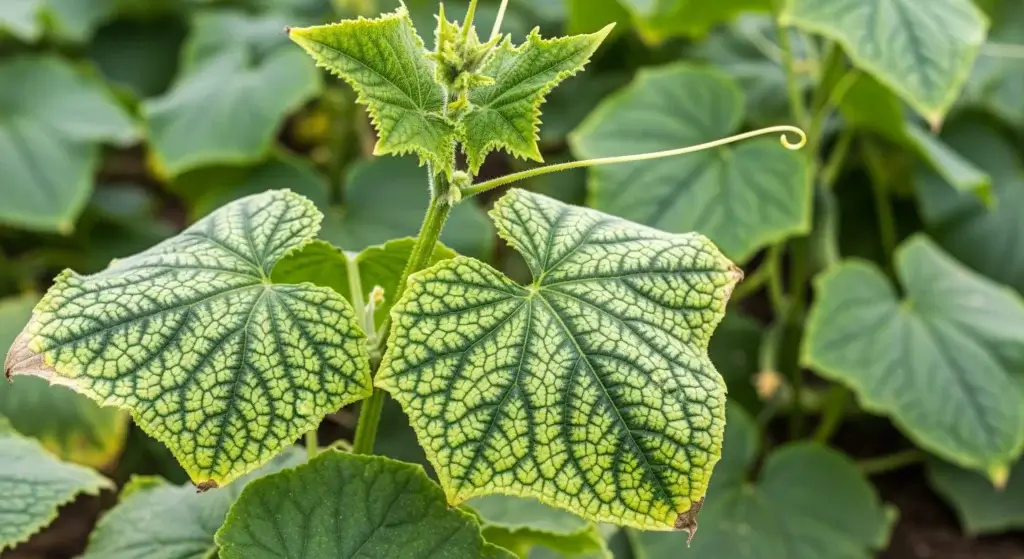
Ever walked out to check on your cucumber plants, only to find them looking sad, spotty, and wilted like they just watched the season finale of their favorite show?
Yeah… you might be dealing with a classic garden villain: downy mildew.
This sneaky plant disease doesn’t mess around—it can turn healthy cucumber vines into mushy disasters fast.
But don’t panic! With the right moves, you can fight back, protect your plants, and keep your harvest strong.
What Is Downy Mildew and Why Is It a Big Deal?
Downy mildew might sound like something out of a fairy tale, but it’s more horror movie than happily ever after.
This fast-spreading garden monster is caused by a sneaky organism called Pseudoperonospora cubensis (yeah, it’s a mouthful).
It loves to crash cucumber parties—along with pumpkins, squash, and other members of the cucurbit fam.
It thrives in warm, humid weather—aka your classic summer garden or steamy greenhouse.
Think of it like the villain that shows up just when your plants are starting to thrive.
Why it’s a big deal:
- It can wipe out your cucumber plants in less than a week. Like, Thanos snap levels of destruction.
- Your harvest? Yeah, it takes a major hit.
- It’s sneaky—spores can spread before your plants even look sick.
How to Identify Downy Mildew on Cucumber Plants
You know the saying, “The early bird catches the worm”? Well, the early gardener catches the mildew before it wipes out your crop.
Here’s your How to Spot It checklist:
Symptoms of downy mildew:
- Yellow spots: Look for angular yellow spots between the veins of the leaves—kind of like a bad sunburn for your cucumber plant.
- Fuzzy gray-purple stuff: Flip those leaves over. If you see a grayish-purple fuzzy growth underneath (think of it like a moldy, fungal sweater), that’s your clue.
- Leaves curling and browning: As the disease takes over, the leaves start curling up and turning brown, like the plant’s having a meltdown.
- Rapid wilting: Before you know it, your cucumber plant looks like it’s had a long day—wilting and drooping in defeat.
Pro tip: Hold a leaf up to the light. If the yellow spots look like they’re trapped inside the veins, it’s probably downy mildew. Your plant’s trying to keep it in like a secret—but it won’t stay hidden for long!

What Causes Downy Mildew?
Downy mildew is a sneaky little villain that loves certain conditions.
Here’s what turns on its superpower:
High humidity (above 85%)
Mildew’s a fan of humidity. If your garden’s like a tropical rainforest, it’s a perfect vacation spot for this fungus.
It thrives when the air is wet and sticky—think “sweaty gym socks” but for your plants.
Warm temperatures (60–80°F / 15–27°C)
Downy mildew’s sweet spot is the warm, sunny weather we love for cucumbers.
It’s like the disease is living its best life in that perfect “beach day” temperature.
Too hot or too cold? Not interested.
Poor air circulation
Plants need to breathe, just like us.
If there’s no airflow (like if your garden is too cramped), mildew can settle in and get cozy.
Think of it like your plants are stuck in a stuffy room with no AC.
Wet leaf surfaces
Mildew loves a soggy leaf!
Overhead watering or rain that wets your plants leaves the perfect conditions for downy mildew to spread.
It’s like giving the fungus a free shower and inviting it to move in.
Spores on the move
Mildew doesn’t just hang around where it starts.
Spores can travel through wind and water, and it can infect your plants just hours after contact.
It’s like an invisible ninja, sneaking in fast!

Step-by-Step Guide: Saving Cucumbers from Downy Mildew
Caught downy mildew in the act? Don’t panic—here’s your plan to fight back and save your crop.
Let’s get your cucumbers back on track!
Step 1: Isolate infected plants immediately
First thing’s first: quarantine the infected plants like they’re a villain in a superhero movie.
If the disease is serious, chop off the infected leaves or even pull the whole plant.
Bag it up—don’t just toss it on the compost pile.
Seal it in trash bags to stop those sneaky spores from spreading.
Step 2: Improve airflow and reduce moisture
Mildew loves damp, stuffy environments.
Let’s kick it out by making your garden feel like a desert breeze.
Space out your plants, clear out the weeds, and make sure air can move freely around them.
When watering, go for the plant base—not the leaves!
Early morning is best, so your cucumbers don’t get soggy all day.
Consider drip irrigation or soaker hoses for better control.
Step 3: Apply organic fungicides
It’s time to go to battle! Organic fungicides are your secret weapon:
- Copper-based sprays (like copper hydroxide or copper sulfate) are the big guns.
- Potassium bicarbonate is like an instant KO for mildew spores.
- Neem oil isn’t just for skin—it works as a mild antifungal too.
- Bacillus subtilis is your plant’s new best friend—this bacteria is a natural enemy of mildew.
Pro tip: Always follow the instructions on the label and spray early in the morning for maximum impact.
Step 4: Boost plant immunity naturally
Just like we take vitamins to stay strong, your cucumbers need the right nutrients to stay resilient.
Feed them with organic fertilizer and consider companion planting (like basil or marigolds) to keep pests and mildew at bay.
You can also give your cucumbers a little boost by spraying them with compost tea—it’s like a spa day for your plants, packed with beneficial microbes.
Step 5: Monitor daily and reapply treatments
You’re on the frontlines now!
Check your plants every 1-2 days, especially during peak mildew season.
Keep reapplying those fungicides every 5–7 days or after a good rain shower.
Think of it like reloading your gear in a video game—stay vigilant!

Preventing Downy Mildew in Future Seasons
They say “an ounce of prevention is worth a pound of cure,” and when it comes to downy mildew, that’s 100% true!
Here’s how to stop the fungus before it even thinks about showing up next season:
1. Grow resistant cucumber varieties
Not all cucumbers are created equal.
Some have special powers (okay, maybe just great resistance) against downy mildew.
Keep an eye out for varieties with DMR (Downy Mildew Resistant) in their name.
These plants are your plant superheroes.
Top resistant varieties:
- ‘Marketmore 76’: Strong and reliable.
- ‘Diva’: The cucumber with all the charm and none of the mildew.
- ‘Katrina’: A name that means business.
- ‘Eureka’: It’s like finding a treasure chest in your garden.
2. Practice crop rotation
If you keep planting cucumbers in the same spot, it’s like giving downy mildew a VIP pass to your garden.
Rotate your crops each season—give cucumbers a 2–3 year break from the same bed.
This keeps the mildew guessing and reduces its chances of coming back for round two.
3. Mulch around plants
Mulch isn’t just for pretty gardens—it’s like a protective shield for your cucumbers!
Apply straw or organic mulch around the base of your plants to stop soil from splashing up onto the leaves.
Plus, it helps keep the soil moisture balanced and reduces the humidity that mildew loves.
4. Use row covers (early season only)
Think of row covers as your cucumbers’ superhero cape when they’re still babies.
Protect them from mildew spores early on by covering them with lightweight row covers.
Just remember to remove them once the flowers show up—gotta let the bees do their pollinating thing!
5. Sanitize tools and surfaces
If you had a mildew showdown this year, it’s time to clean up your act.
After dealing with infected plants, disinfect your tools and surfaces using rubbing alcohol or bleach.
Make sure you clean those containers and trellises too—anything that touched the plants needs to be mildew-free for next season.

Conclusion: Don’t Let Downy Mildew Win
Downy mildew might try to mess with your cucumbers, but you’ve got the power to stop it in its tracks!
By spotting the symptoms early, keeping your garden tidy, using the right treatments, and choosing resistant varieties, you can keep your plants safe and your harvest plentiful.
Every gardening challenge is just another chance to level up your skills.
Follow these steps, and you’ll be sipping cucumber water while others are still dealing with those pesky mildew problems.



